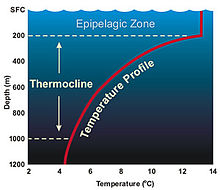Thermocline
A thermocline (from old-Greek : thermós = warm and klínein = incline) is the transition from water layers of different temperatures . More detailed measurements showed that comparatively homogeneous water layers of the metalimnion often border each other in sharp temperature jumps of a few centimeters thick, so that a system of thermoclines exists that reflects the history of mixing events in the lake that have reached different depths. The original definition in limnology used the thermocline as the depth with the maximum temperature gradient in a supposedly continuous transition range of temperatures in the metalimnion of a lake .
The formation of thermoclines is caused by the temperature-related differences in density of the water layers. Differences in density can also be caused by different contents of dissolved solids. In general, therefore, one speaks of pycnoclines , in the case of jumps in the solution content of chemoclines .
Thermoclines are part of the temperature stratification of lakes and seas . Their location and characteristics vary with the seasons. Due to the density anomaly of the water, the summer has warmer water layers over colder ones with a minimum temperature of 3.98 ° C. In winter, on the other hand, layers of water with lower temperatures are on top.
At chemoclines it can happen that warmer, but nevertheless denser layers of water lie under colder ones. This is mostly the case in meromictic lakes and occasionally also occurs in the sea with high salty hot water leaks. Allegedly divers are said to have already scalded themselves.
Sound anomalies also occur at thermoclines, which submarines can use for camouflage. Sonar can penetrate this layer but does not provide accurate results. Another sound anomaly is the convergence zone .
Other, trivia
The defense research vessel Planet measures salinity , density , currents and other hydrographic parameters that influence the thermocline on its voyages .
In the novel Red Storm Rising by Tom Clancy uses a submarine, a thermocline.
In the film Meg , a research team discovers a previously unknown, untouched deep-sea trench with prehistoric fauna, especially the eponymous basking shark Megalodon, under a thermocline at record depth.
